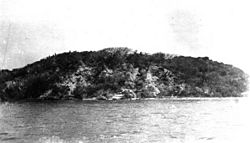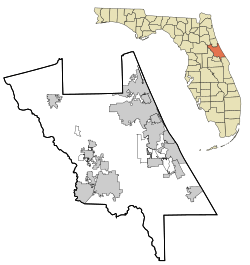Turtle Mound facts for kids

A photo of Turtle Mound in 1915
|
|
| Location | New Smyrna Beach, Volusia County, Florida, |
|---|---|
| Region | Volusia County, Florida |
| Coordinates | 28°55′51″N 80°49′37″W / 28.93083°N 80.82694°W |
| History | |
| Founded | 1000 BCE |
| Abandoned | 1400 CE |
| Cultures | Timucua |
| Site notes | |
| Architecture | |
| Architectural styles | shell mound |
| Architectural details | Number of monuments: 1 |
|
Turtle Mound
|
|
| Lua error in Module:Location_map at line 420: attempt to index field 'wikibase' (a nil value). | |
| NRHP reference No. | 70000193 |
| Added to NRHP | September 29, 1970 |
| Responsible body: State of Florida | |
Turtle Mound is a very old historical site in Florida. It's located about 9 miles (14 km) south of New Smyrna Beach. This amazing place was added to the U.S. National Register of Historic Places on September 29, 1970.
It's the biggest shell midden (a pile of shells and other waste) on the mainland United States. It stands about 50 feet (15 meters) tall. The mound stretches for over 600 feet (183 meters) along the Indian River shoreline. It contains more than 35,000 cubic yards (26,760 cubic meters) of shells! People think Turtle Mound was once 75 feet (23 meters) high. But it got smaller because of shell mining in the 1800s and 1900s.
The mound is shaped like a turtle and is made mostly of oyster shells. It also contains other things left behind by the ancient Timucuan people. Experts believe these people might have used the mound as a safe, high place during hurricanes. They hunted small animals and reptiles using bows, arrows, spears, and snares. The mound was built between 800 and 1400 CE. However, newer tests suggest it might be even older, around 1000 BCE. Early Spanish explorers and sailors used this huge mound as a landmark to guide their ships. Today, the National Park Service takes care of Turtle Mound as part of Canaveral National Seashore.
What is Turtle Mound?
Turtle Mound is a huge pile of shells and other things left behind by people long ago. It's called a shell midden. It's mostly made of oyster shells. This mound is special because it's the largest shell midden on the mainland of the United States.
It's so big that sailors could see it from seven miles (11 km) out at sea. They used it like a giant lighthouse to help them navigate. The Timucuan people, who lived here, faced challenges finding enough land and food. This sometimes led to conflicts. Turtle Mound was an important spot along the coast for them. Recently, archaeologists found pottery on the site that is 1,200 years old.
Plants and Animals at Turtle Mound
The shell mound is made mostly of oyster shells. Scientists haven't dug into it a lot, but they know it has many different kinds of tropical plants. Some of these plants are usually found further south. This site is the northernmost place where some of these plants grow.
The shells in the mound hold heat, and being close to the Atlantic Ocean keeps the area warmer. This helps these special plants grow here.
History of Turtle Mound
Turtle Mound has had many names over time. In the 1500s, it was called Surruque. This name came from the chief (called a cacique) and the Native American tribe who lived there. Later, it was called Mount Belvedere, The Rock, Mount Tucker, and finally Turtle Mount.
In 1605, a Spanish explorer named Alvaro Mexia visited the mound. He saw Native Americans launching their dugout canoes from the base of the mound. Over many years of doing this, the mound started to look like a turtle. That's how it got its current name!
Gallery










